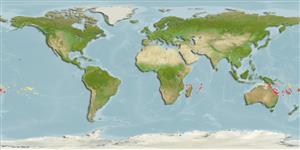>
Ovalentaria/misc (Various families in series Ovalentaria) >
Pomacentridae (Damselfishes) > Pomacentrinae
Etymology: Amphiprion: Greek, amphi = on both sides + Greek, prion, -onos = saw (Ref. 45335).
Environment: milieu / climate zone / depth range / distribution range
Écologie
marin récifal; non migrateur; profondeur 1 - 25 m (Ref. 7247). Subtropical; 10°S - 32°S
Western Pacific: eastern Australia (Great Barrier Reef and Coral Sea, northern New South Wales), New Caledonia, and Loyalty Islands. Recently reported from Tonga (Ref. 53797).
Taille / Poids / Âge
Maturity: Lm ? range ? - ? cm
Max length : 9.0 cm SL mâle / non sexé; (Ref. 7247)
Épines dorsales (Total): 10 - 11; Rayons mous dorsaux (Total): 14-17; Épines anales 2; Rayons mous anaux: 13 - 14. Body and head orange with two black-edged white bars; the first running from the top of the head across the face, just behind the eye; the second from the mid portion of the dorsal fin. Caudal peduncle and caudal fin white.
Life cycle and mating behavior
Maturité | Reproduction | Frai | Œufs | Fécondité | Larves
Oviparous, distinct pairing during breeding (Ref. 205). Eggs are demersal and adhere to the substrate (Ref. 205). Males guard and aerate the eggs (Ref. 205). Also Ref. 7471.
Allen, G.R., 1991. Damselfishes of the world. Mergus Publishers, Melle, Germany. 271 p. (Ref. 7247)
Statut dans la liste rouge de l'IUCN (Ref. 130435)
Menace pour l'homme
Harmless
Utilisations par l'homme
Aquarium: Commercial
Plus d'informations
RéférencesAquacultureProfil d'aquacultureSouchesGénétiqueElectrophoresesHéritabilitéPathologiesTraitementNutrientsMass conversion
Outils
Articles particuliers
Télécharger en XML
Sources Internet
Estimates based on models
Preferred temperature (Ref.
123201): 24.6 - 27.9, mean 26.4 °C (based on 559 cells).
Phylogenetic diversity index (Ref.
82804): PD
50 = 0.5000 [Uniqueness, from 0.5 = low to 2.0 = high].
Bayesian length-weight: a=0.02455 (0.01556 - 0.03872), b=2.96 (2.83 - 3.09), in cm total length, based on LWR estimates for this species & (Sub)family-body (Ref.
93245).
Niveau trophique (Ref.
69278): 2.7 ±0.29 se; based on food items.
Résilience (Ref.
120179): Haut, temps minimum de doublement de population inférieur à 15 mois (Preliminary K or Fecundity.).
Fishing Vulnerability (Ref.
59153): Low vulnerability (10 of 100).
Nutrients (Ref.
124155): Calcium = 81.6 [33.8, 152.1] mg/100g; Iron = 0.775 [0.439, 1.462] mg/100g; Protein = 18.8 [17.6, 20.1] %; Omega3 = 0.177 [0.093, 0.330] g/100g; Selenium = 10.6 [4.7, 22.7] μg/100g; VitaminA = 62.5 [14.7, 244.4] μg/100g; Zinc = 1.28 [0.77, 2.03] mg/100g (wet weight);
